A scientific project in the jungles of Guyana allows visitors to actively engage in the capture and research of black caimans
During the rainy season, from May to August, the Rupununi River of the Guyanese interior gushes over its banks. This flooding turns many of the nearby savannahs, the size of Connecticut, into swamps so vast that they connect the Amazon and Essequibo watersheds. These marshes are a mythic place, believed by some historians to be the source of the legend of Lake Parima—the site of El Dorado, the lost city of gold—and beloved by many naturalists for the riot of life that swarms about them.
But the Rupununi of the dry season is a very different place. The savannahs desiccate. The life retreats. The river shrinks at points 10 to 15 feet below its steep, sandy banks, running cloudy, shallow, and slow. The fish bite less. The birds call soft. The brush on the banks buffers out the skies.
Drifting along the dry river in the dead of night, shrouded in darkness and listening to the soft gurgle of muddy water and rustle of dry branches, is an almost womblike experience. But if you wave a flashlight across the surface of the water, you’ll notice that it occasionally flashes off of little orbs floating in stationary pairs. They’re eyes. They’re watching you from the murky shallows. They’ve been watching you all the way down the river’s amniotic calm, peering just above the surface.
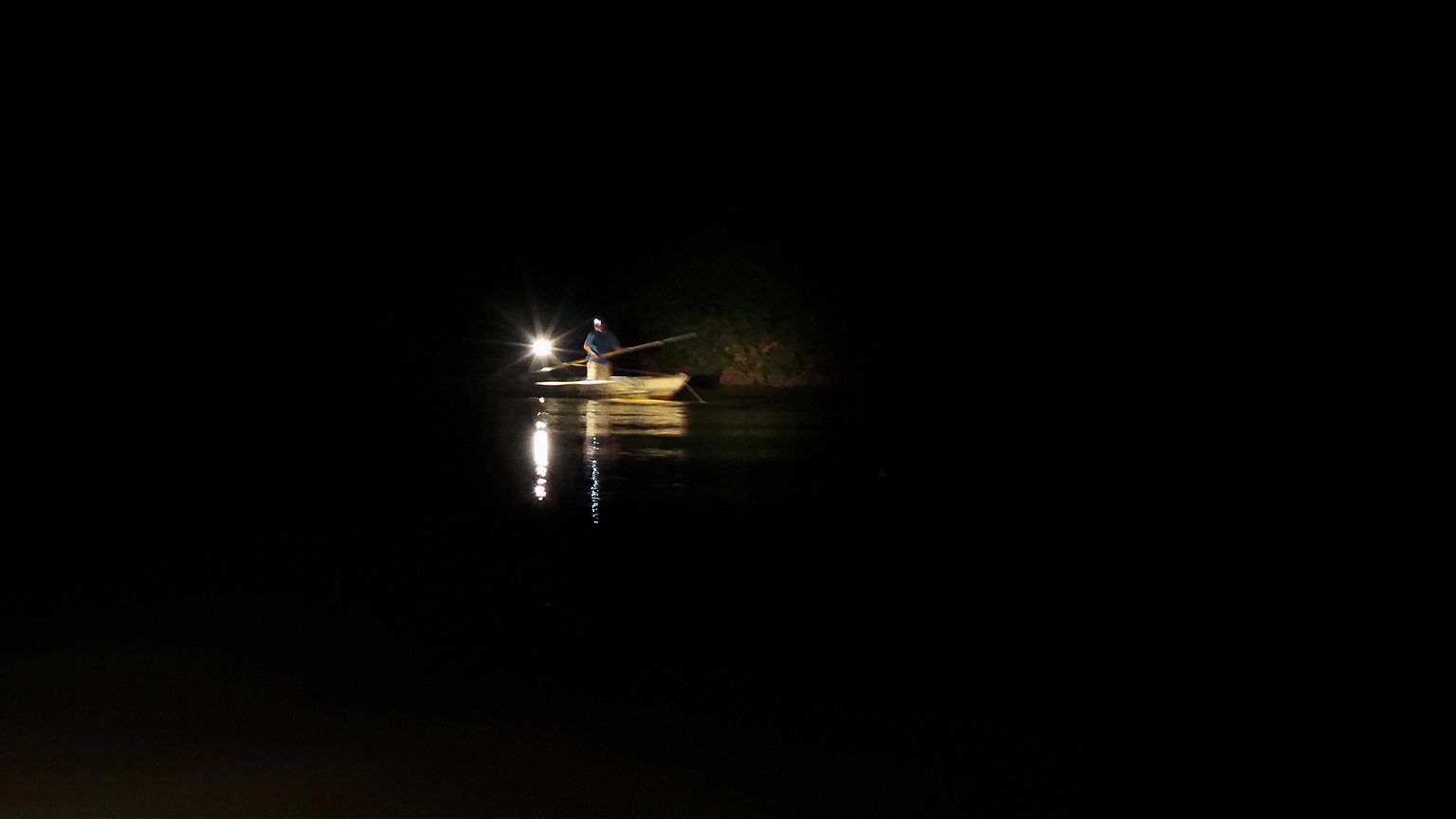
Each eye flash is a black caiman. These beasts look like American alligators, but with narrower snouts lined with bony ridges. They are the biggest members of the alligatoridae family, and the largest apex predators in the South American rainforests. Adult males average 12 feet long and over 650 pounds and can reportedly reach 20 feet long and over 900 pounds. Once common throughout the continent’s jungle shallows, heavy hunting through the mid-20th century reduced their population by almost 99 percent to under one million, spread across mostly small and threatened pockets from Bolivia to French Guiana. But the population on this stretch of river, estimated at 3,500 adults, is among the most robust left in the world. The Rupununi is a land of giants—giant anteaters, armadillos, otters, snakes, spiders, and rodents. But the caiman is still king; although they don’t often go after humans, they can easily take us down—or really anything else that needs to be killed.
Standing at the bow of his tin boat, Fernando Li, a solemn and thickly muscled man from the local Makushi population, catches an eye flash in his light and, holding it in the beam, signals for the motormen to stop. The motor in the boat in which I’m crouched is killed and we drift up close to Li’s. Josie George, another Makushi from a nearby town, sits at the bow of our boat and sweeps his own light towards the caiman. As he does, Li stands up and, his boat creeping towards the eerily calm eyes, slowly hefts up a 10-foot snare pole and extends it out over the water. In the hazy edges of George’s lamp, I notice that the side of Li’s boat is peppered in dents and dings. Some look oddly like jagged fang marks.
This little man is about to catch a black caiman—to subdue what we later learn is a 10-foot crocodilian pushing 300 pounds—with his snare pole and his tin boat. He’s not doing it for glory or food or the amusement of anyone in my on-looking boat. He’s doing it for science. And we get to watch.
Suddenly, the snare drops over the caiman’s head and Li jerks it back to tighten the noose. Immediately, his motorman blasts the engine into a hard reverse. The caiman cracks and lashes out of the water, pulling against the snare and the outboard with all his might. His head slams the tin. He grunts and groans like thunder. Li holds fast to the snare and, after minutes of struggle, the caiman tires out. Li grabs his jaws and holds them shut up against the side of the boat while another man pulls out a roll of pink duct tape, circling it round and round his snout until he is fully subdued.
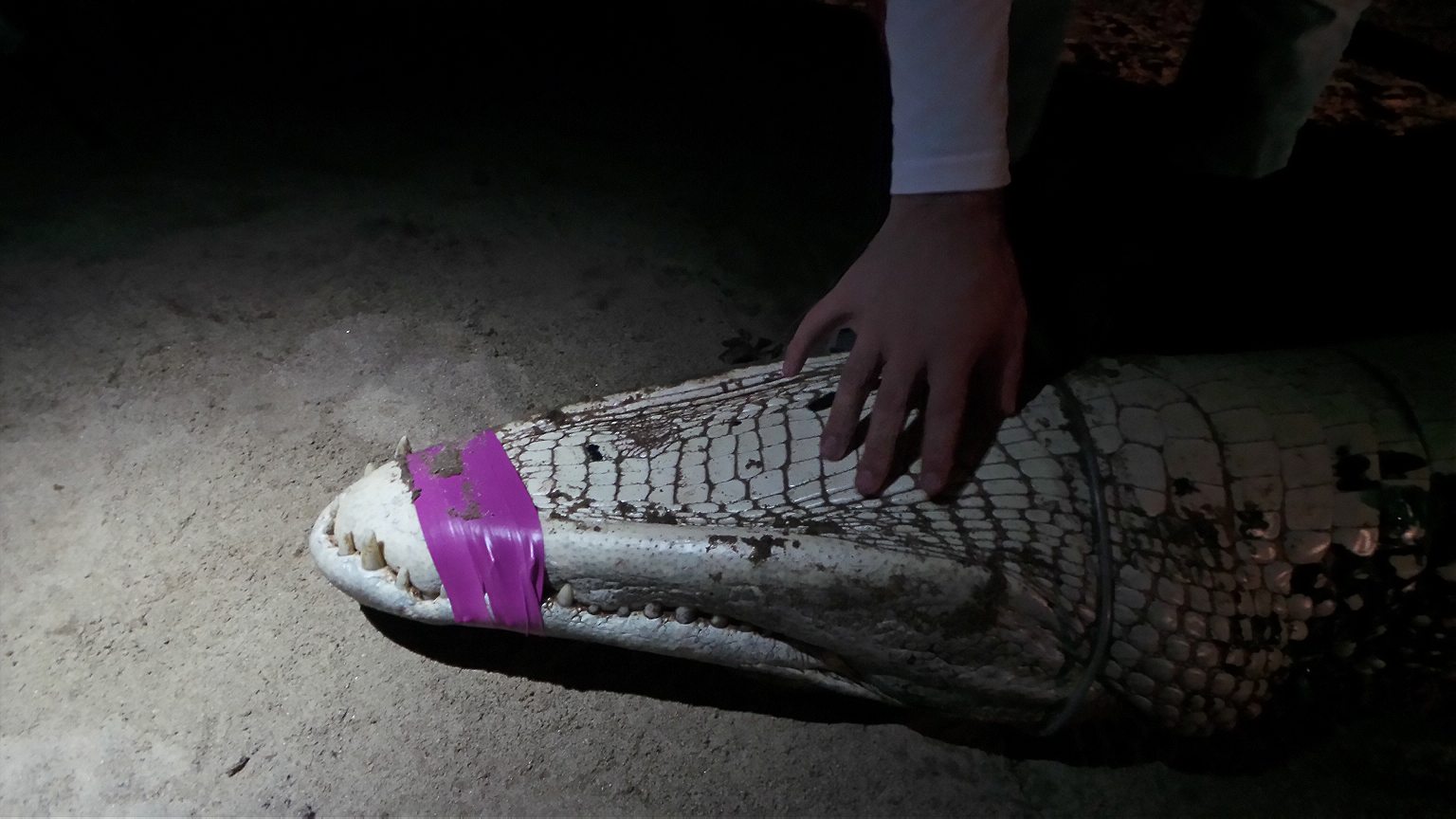
The boats drag the animal towards a sandbank, then everyone jumps out and hauls his mass up onto the sand. The exhausted caiman just sits there, waiting and watching, while the team breaks out rulers, scales, probes and vials, and proceeds to measure, determine the sex of, visually assess, weigh, and plant a serial number chip into him. They also cut off three of his spines, representing his number on their spreadsheets as a way to re-identify him if he loses his ID chip and they happen to recapture him. Then we drag the violated caiman to the edge of the water. I’m given the honor of undoing the duct tape around his jaws. Once they’re released, I and the men holding him down all launch ourselves backwards, waiting to see whether he lashes back at us. But this one just slides back into the dark waters.
My friend Kara and I have just participated in the Caiman Project. An ongoing study carried out by the Makushi village of Yupukari (really a collection of smaller communities totaling 1,000 people) for nearly 15 years, the project is one of several efforts to learn more about a single remote predator. Each study involves similar visceral struggles repeated hundreds of times over years and years, slowly building up a complex demographic and ecological profile that will eventually be nonchalantly condensed onto a child’s National Geographic animal fact card. Caiman House, the Project’s home base in Yupukari, is one of the only places in the world where you can actively engage in this often hidden research process as an outsider, gaining a deeper understanding for the grit of biology. And the story of how the house opened its research to tourists is itself a telling tale of the struggles some zoologists face to keep such a study going.

Caiman catching is not some traditional Makushi practice now being leveraged by scientists. Peter Taylor, an American animal wrangler and devoted reptile lover, founded the Caiman Project in 2001 while managing the St. Louis Zoo’s reptile house as a venue to enhance his herpetological studies. His then-wife Alice Layton joined him there, setting up many village programs parallel to the project. According to Layton, when she first arrived in Yupukari, no one had ever caught a caiman before. In fact, while the locals had a wealth of knowledge about every plant and animal with any remote use, they’d never learned much about big predators—creatures that seem more dangerous than potentially useful to everyday life.
The only time Yupukari troubled itself with caiman before the millennium at all, according to George, was to kill them—not for use or study, but because they’d become problematic. Josie recounts the story of a huge local one-eyed caiman that, unlike others that kept to themselves, one day made a rush for a villager, nearly killing him. After deliberating for a time, the villager who’d escaped death came to the bank with a small group of people with a ‘snappy’—an old, oft-misfiring rifle—and decided to “wipe this creature out of this world.” But attacks and retributions like these (contrary to the impression given in old and even modern jungle adventure books like Matthew Reilly’s 2012 Temple or James Rollins’ 2002 Amazonia, where caiman gobble people up on the regular) are incredibly rare. No one went out looking for such confrontations.
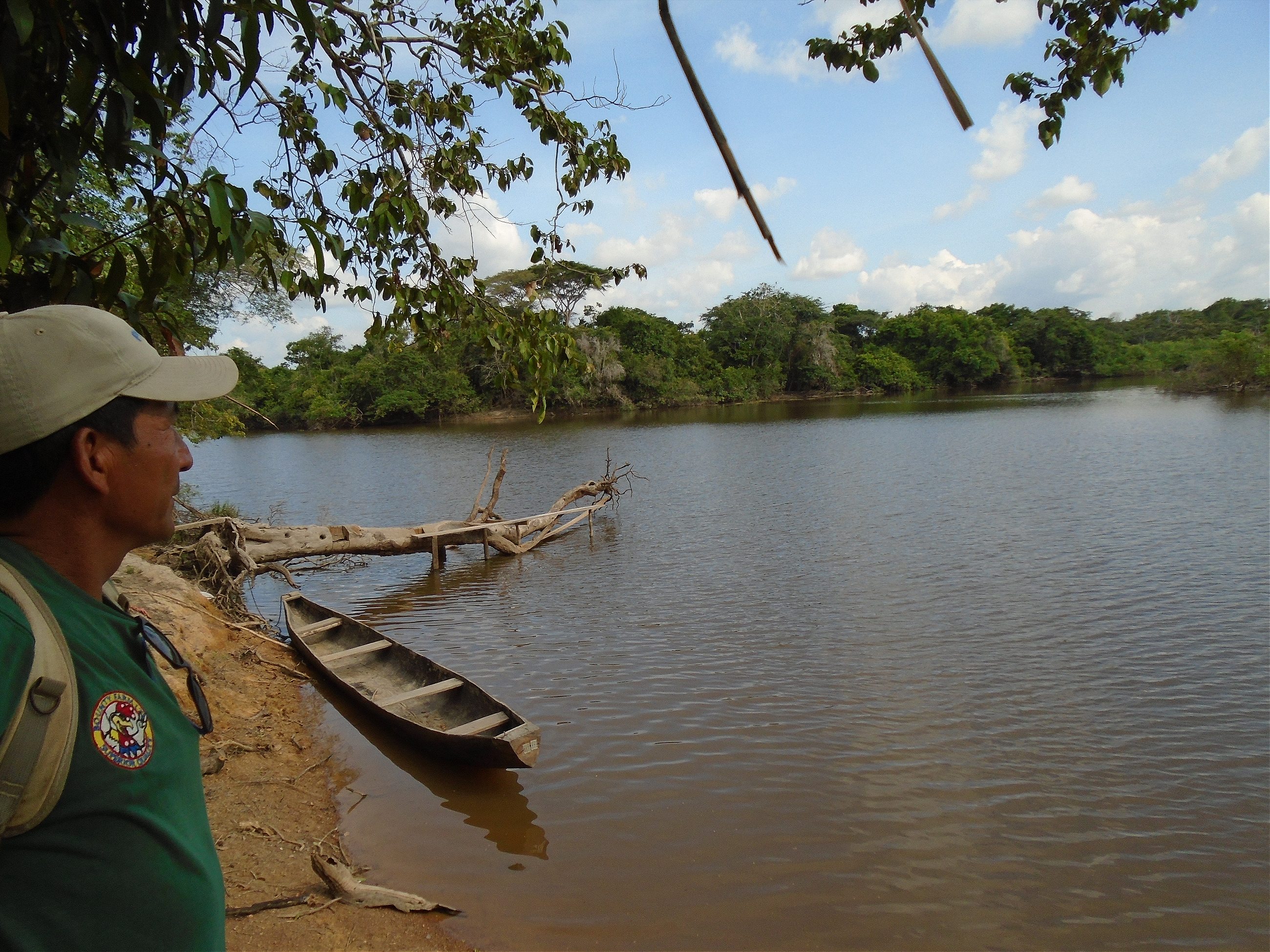
“They’ve told me that at the beginning of the project they didn’t know anything about caiman other than stay the fuck away,” says Adam Rosenblatt, a post-doctoral associate studying large predators at Yale’s Schmitz Lab. Rosenblatt has been using Caiman House and its data in his work for the past few years. “I would say they had respect for them. But more it was just straight-up fear.”
There’d been a few studies of healthy black caiman populations elsewhere, like those in the Mamirauá Sustainable Development Reserve in the Brazilian Amazon, where Ronis da Silveira of the Instituto Nacional de Pesquisa da Amazônia, a field leader, carries out his research. But thanks to the inaccessibility of robust populations and the difficulty associated with regularly catching 400-plus-pound caiman, the insights of these studies, mainly conducted since the 1980s, have been relatively limited. The difficulty of recapturing black caiman, which learn to avoid snares and hide after just one encounter, especially stymies data about their growth rates, movement patterns, and ecological niche. Scientists don’t have reliable census estimates of their population and don’t know for sure how long they live in the wild. Nor do they know exactly what or how much they eat and therefore what role they play in local ecologies.
It was in this context of limited engagement and relative ignorance that Taylor first made his way to the Rupununi. Although the reptile manager of the St. Louis Zoo and a herpetological nerd from birth (the family story is that the first steps he took were to catch a frog), he only had a bachelor’s degree by the late ‘90s. So he’d enrolled in a grad program at the University of Missouri, St. Louis, and followed a Guyanese professor home for a research trip on frogs.
Their team stayed at Karanambu, a cattle ranch and balata-bleeding station (i.e. a place from which locals set out to tap local non-elastic rubber trees) founded in 1927 and turned into an eco-lodge a few years before Taylor’s arrival by its second-generation owner, Diane McTurk (whom locals claim had a tryst with David Attenborough when he traveled there for his first major show, Zoo Quest, on and off in the 1950s and 1960s). Taylor walked down to the river landing one night at dusk and saw black caiman all about. Thanks to its obscurity and lack of development, he realized, Guyana had preserved a pristine and wholly unstudied population of these little understood creatures. He decided he needed to take advantage of this astounding natural resource, so he scurried home and convinced Layton to take their son, Raph, and move to the Rupununi.
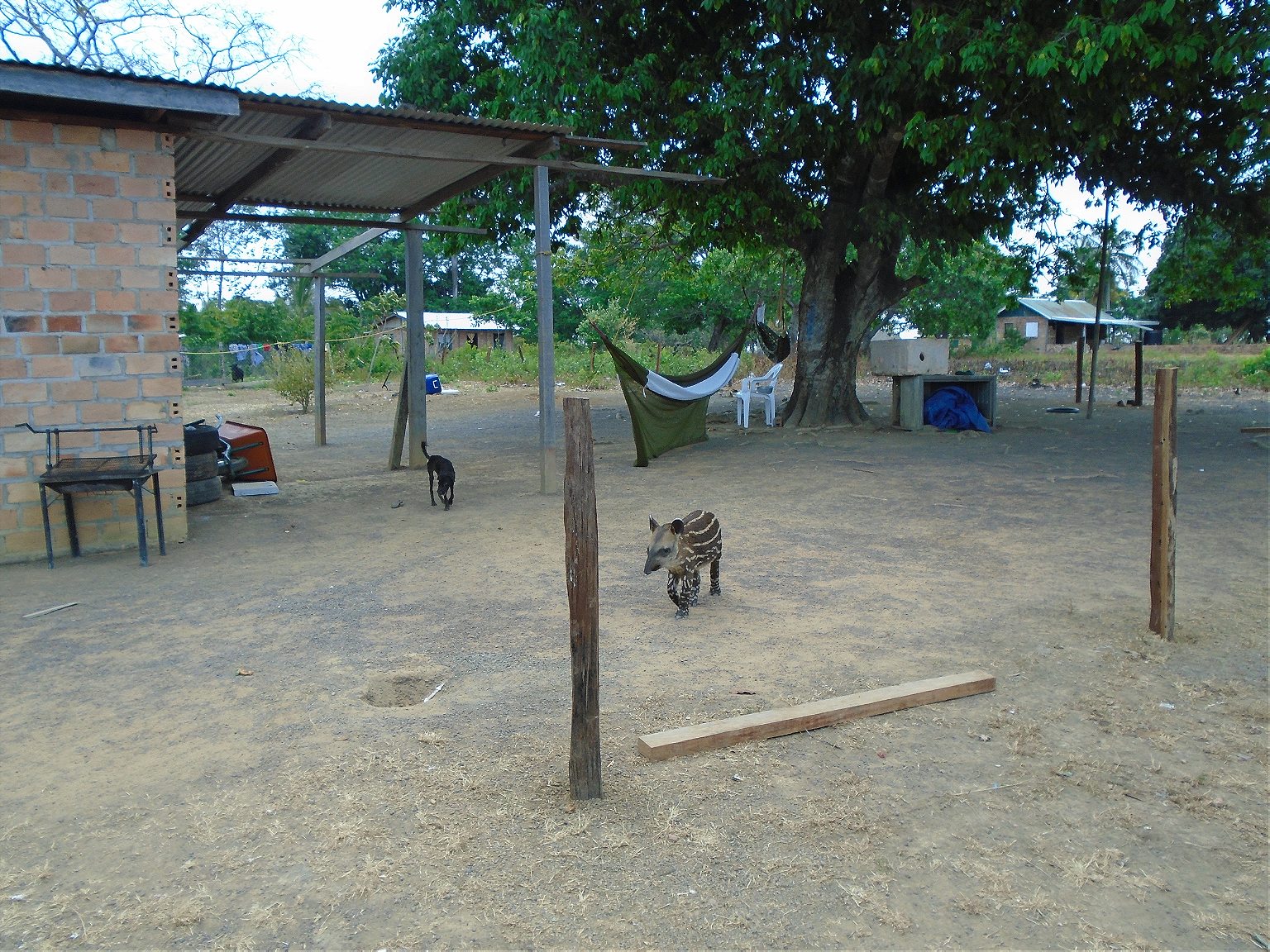
The move took some time. First, the family traveled to Karanambu to feel out which of the local communities would be the best to live and work in. Layton, unimpressed with the school in nearby Massara, asked McTurk to point her to the best school in the area, which turned out to be a new one-room cinderblock building with a single blackboard in Yupukari. After multiple trips and years of negotiation, they decided to launch the project there—only later learning that neighboring villages considered Yupukari a town of drunkards, the least reliable in the area.
For their part, the folks in Yupukari regarded Taylor and his family with caution at first. “We thought he was crazy,” recalls Li, “talking about catching caiman.” But Layton suspects that their whiteness was a bigger source of concern for most locals. “White people to them represented dominance, untrustworthiness,” she says. Only the mediation of McTurk and Sydney Allicock, then a tourism developer in nearby Surama and now the national Minister of Indigenous Peoples Affairs, got them a two-year contract to provisionally set up shop.
Taylor picked a group of eighteen able-bodied men with some hunting, tracking, or guide skills to work with him as paid assistants. Based on his experiences as a large reptile keeper, he trained them how to capture, assess, and release black caiman. At first they were going out every night, and the village was excited about the venture. Caiman were becoming demystified and routine. (And, although no one’s ever studied the effect of captures on caiman behavior, Rosenblatt suspects they might’ve grown warier of people, decreasing the risk of attacks—a bonus.) But the study nearly ended just a few years in—as a not insignificant number around the world do—due to a violent flurry of red tape.
The powers that be were extremely offended that I was washing their dirty laundry in public
Layton had gotten involved in community development work in the village. She kept a website for her projects in which she talked about the lack of resources in and needs of Rupununi towns.
“The powers that be were extremely offended that I was washing their dirty laundry in public,” she recalls. “It’s absurd of course because what do they do when they want money? They go to the World Bank and they say, ‘We do not have! You must give!’ But I wasn’t allowed to do it.”
First they revoked Taylor’s work permit in 2007. Then they sent threatening letters to the village. Eventually border control forces showed up and deported the couple and their son at gunpoint in the clothes they were wearing, leaving the project and the facilities it had developed high and dry. They hadn’t even gotten to share the research with anyone to write a paper using it yet.
For most field stations, that would have been the end. Usually researchers set up in a community, recruit a few people, bring in some cash for a time, and perhaps build up interest in ecology and natural stewardship amongst that small cohort. But as soon as the moneyed scholars leave, the guides who were involved do not have the luxury of perpetuating the projects, nor of taking their interest in environmentalism much further, especially if they’re extremely resource poor (like Yupukari reportedly was at the turn of the millennium). Hopefully the research scientists needed is completed by that time—but that’s not always the case. At Yupukari, though, research continued even without Taylor, building up stronger datasets autonomously over time.
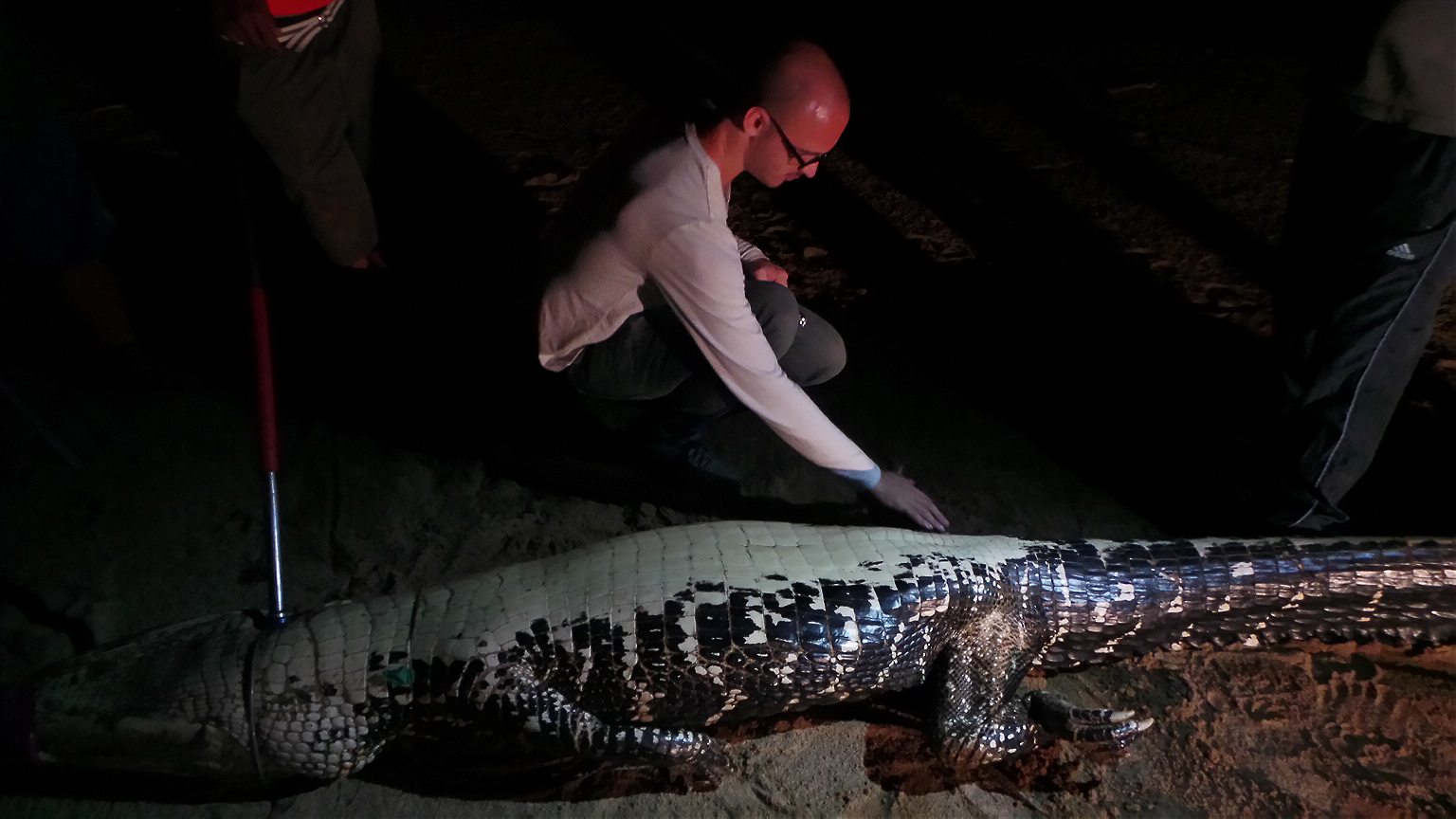
The success of the Caiman Project over the long term comes down partially to Layton and partially to McTurk and a cadre of Karanambu tourists who’d overstayed their welcome (although they were both just facilitators, ultimately, for the efforts of local workers).
Faced with the one-room school of Yupukari, Layton, then a social worker, decided that she’d see at first if there were any educational opportunities she could work on with the villagers. She floated the idea of creating a library—a means for locals to have access to information, but not have some outsider dictating how they used it. The idea went down well and from there she founded Rupununi Learners, now a network of cooperatively conceived social development projects. Many of these projects—crafter’s associations, after school programs, and so on—were based out of the Caiman House, the thatch-roofed, locally-built structure housing Taylor’s research program as well. The association of these development efforts with and consolidation of village activities into the space of the project helped build a positive perception of and village-wide engagement with and investment in Taylor’s purely scientific and limited project.
“I think that one of the reasons why [other] field stations don’t do what Caiman House does,” she says, “is that they don’t touch enough other people in the community” beyond capture assistants.
The project also figured out how to monetize itself early on when, just a few months into the study, McTurk radioed the couple to tell them that she had a bunch of tourists at Karanambu and not many activities left for them to do. She asked if they could meet Taylor on the river that night and watch his team do their stuff. Taylor agreed and the Karanambu crew showed up with their own boat and a giant vat of rum punch. Spontaneously, Taylor and his crew invited the tipsy tourists to get hands-on with the research process once they’d subdued the caiman onshore.
“The next day they were raving about this experience,” Layton recalls, “saying that there was nowhere else in the world where you could do that sort of thing.”
(Rosenblatt, who’s worked at field stations from Australia to Belize, supports these tourists’ assertion, even years later. He says that while some researchers build dedicated ecotourism components to fund their projects or the communities they work in, usually it’s a stunt—like feeding whole chickens to saltwater crocodiles in Australia to watch them propel their full body length out of the water with their massive tails. The research itself is often an opaque affair.)
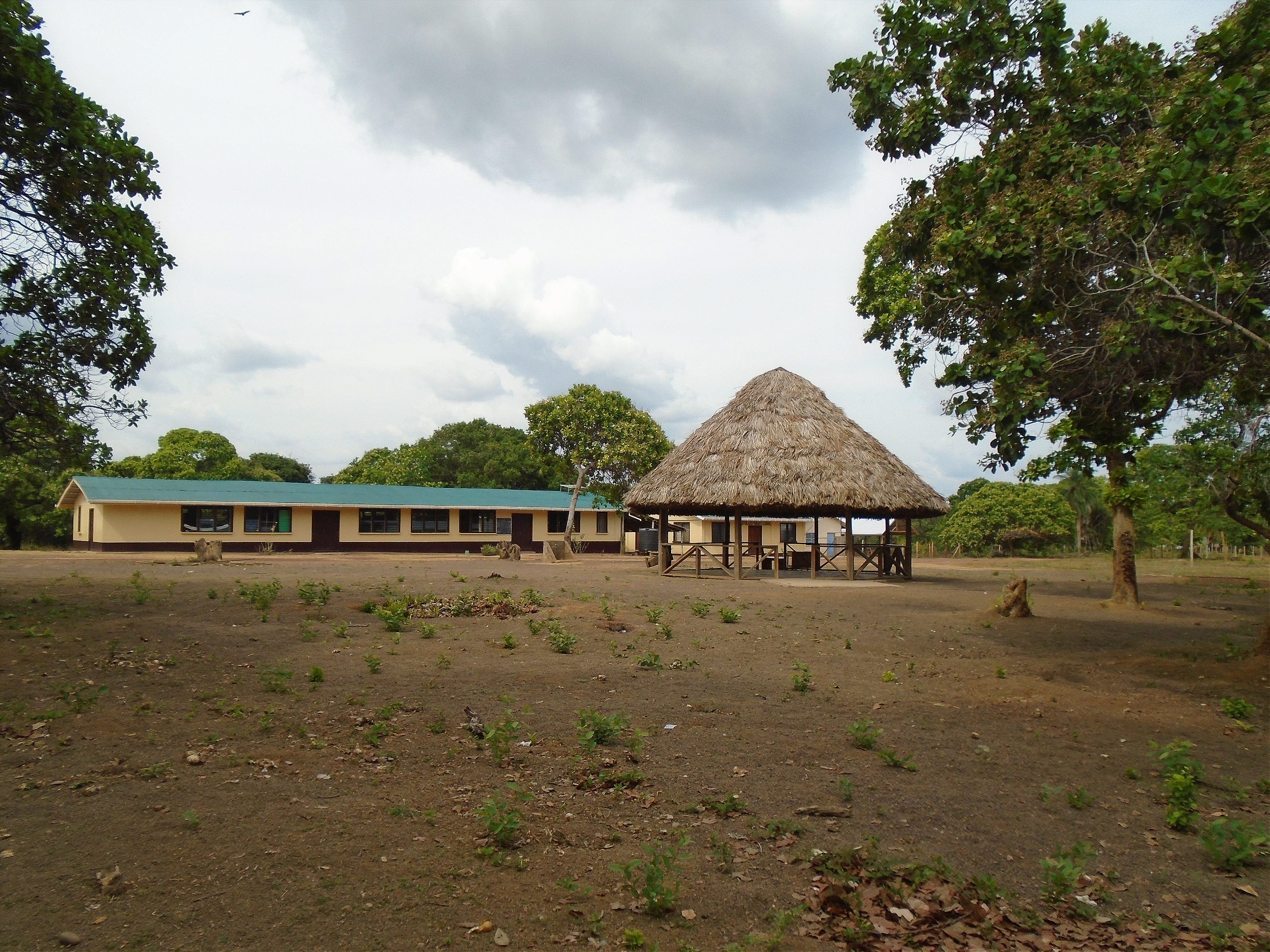
Naturally, the couple decided to replicate the experience—at a price. At first they charged Karanambu tourists $50 per visit. Then they realized that they could generate even more money and attract even more people to engage with the Caiman House and project, if they hosted their own tourists. By 2007, they’d built a guesthouse right next to Caiman House: four well-appointed rooms with solar powered electricity and wifi access via the house’s satellite internet system. With all revenues beyond supporting the house going to village education projects and many more locals employed peripherally by the project (guides for wildness tours, cooks for the house, and crafters for souvenirs and maintenance), the tourist fusion made the project both viable and fiscally desirable to continue no matter what happened to Taylor and his initial plans.
Granted, tourism in Guyana is low; Layton says that in a good year the guesthouse gets just 400 visitors and that in bad years she still has to help prop it up. But Rosenblatt’s looked over the house’s finances and quantified how much each individual caiman captured has generated for the village. Looking at not just the price of the outing, but what people pay to travel to, stay at, and participate in other activities based in the house, he recons that each caiman caught brings in between $300 and $700. As of the night we visited, they’d captured over 730 individuals, many of whom had been recaptured at least once. (Li captured one new caiman, a seven-footer, and recaptured one, the 10-footer, while we were out.)
Whatever the net income, it’s a significant value for the region. Without dedicated funding, the project can’t go out every night. But the engagement and profit generated by fusing scientific research with social development and tourism allowed the project to outlive Layton and Taylor’s presence. (Layton made it back in 2010 for a few months before being deported again.)
Apparently the state saw the fiscal value in keeping the project alive as well. While they ousted the foreign couple, they allowed Caiman House to keep on chugging. And as it began to win ecotourism awards, they even featured it in national handbooks on environmental hospitality.
By the time Rosenblatt learned about the Caiman Project, it’d gathered over 10 years of data that was up for grabs for any new researcher who wanted to take it on. That data was incredibly deep; at least one individual on the list had been recaptured seven times, creating great growth records.
“I can’t explain why he lets himself get captured over and over again,” muses Rosenblatt. “Maybe he’s not the brightest caiman in the bunch.”
Time and practice also allowed the locals to gain an uncanny expertise in tracking and snagging caiman. Rosenblatt says that Li, one of the most experienced catchers and the manager of the house these days, can catch almost anything. He knows how the animals think, where they congregate, and how to use his snare and boat crew to his perfect advantage. Rosenblatt’s helped the team to snag their largest caiman on record, a 12.5-footer that weighed 450 pounds. But he was just one of seven more experienced men working to subdue that monster.
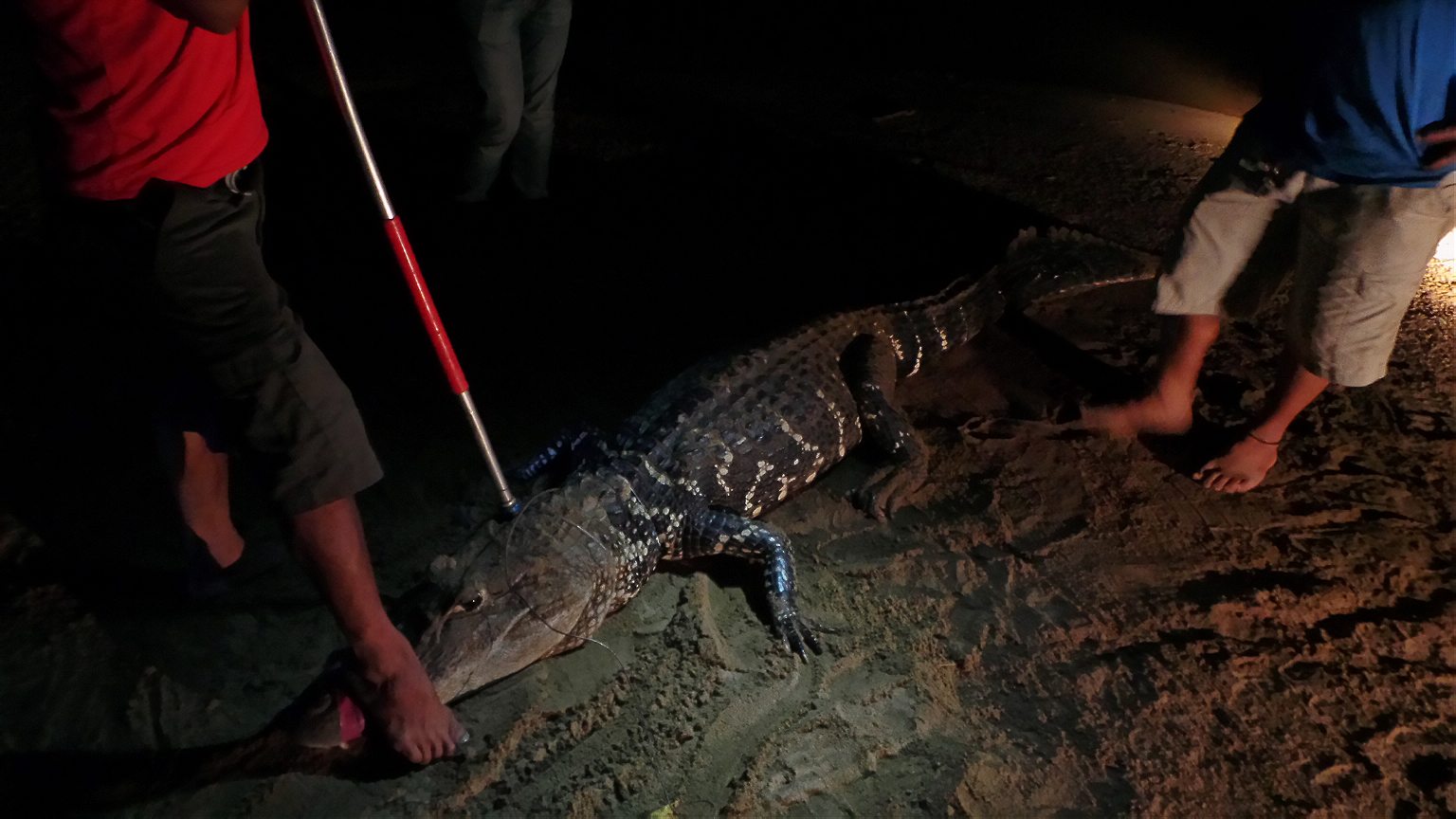
By comparison, one of the only other long-term tracking and measuring studies on black caiman that Rosenblatt is aware of comes from da Silveira’s team, which followed hatchlings for just five years. Rosenblatt’s now using the house data to study the growth rates, ecological dynamics, and movement and population of this community. (This can be fused with research on other populations to get a sense of the species at large to learn how to better conserve them.) He’s also used his own funding to expand the training and methods used by the center, pumping caimans’ stomachs to see what they’ve eaten—and to compare their eating habits to local beliefs that caiman destroy local fish stocks, threatening fishermen (who’re actually the likely over-consumers). So far he’s published two papers based on the Caiman House data and plans three more. (Taylor seems to have used his research on one paper back in 2011, so far as I can tell.)
The community’s also using their research facilities and experience to invite in new scientists and their projects. Caiman House now supports a jaguar population study in the nearby Kanuku Mountains for Matt Hale of the University of Florida; a yellow-spotted Amazon River Turtle conservation project started by an intern at the house from Lesley University (one of many intern projects, but the only one related to animal research that I am aware of); and it is participating in training for bird field research techniques with the Guyana Amazon Tropical Bird Society. The capacity and expertise they offer as a self-managed station is incredibly valuable to outsiders looking to explore the under-studied yet immense, impressive biodiversity of the Rupununi area.
This uniquely successful research platform isn’t just useful for scientists, or the many students and interns who come out over the years for study and half-research vacations. It’s become a must-visit spot for the few tourists who come into the interior. Some just come to see and support a local enterprise—it is, as Layton says, one of the only places that you can sit on a couch and breezily share a coffee with a slash-and-burn jungle farmer as a casual outsider. (That said, some tourism agencies refuse to work with Caiman House for that reason, telling Layton that their clientele wants a sterile safari experience, and not “a smelly farmer.”) But Rosenblatt believes that one of the biggest things people get out of “caimaning,” as going out on the project is known, is a deeper sense of the effort that actually goes into conservation and environmental research.
When he goes out with tourists, Rosenblatt gets a kick out of getting folks used to observing from afar to “touch some caiman penis” (i.e. test the sex of the animals; I refused to do this when Josie invited me to, not wanting the caiman whose jaws I’d be untaping to associate me with harassment). But I don’t think he’s just trying to gross people out. I think he’s doing what Caiman House, quite by accident and through great trials, does best—aside from catching and gathering data on a massive reptile. He’s exposing people to the visceral realities, so often hidden behind controlled tourist experiences or scientific polish, that go into conservation and ecological research. He’s making them understand the effort that goes into what can seem on the TV and in pamphlets and papers, like a genteel endeavor. He’s making people roll up their sleeves and tussle about in the sand with a 400-pound predator like a goddamn scientist.
It’s not just a demystification of and connection to the caiman. It’s simultaneously a demystification of and connection to the demystification process itself. Hopefully that closeness will engender the kind of respect that leads to further participation, hands-on volunteering or hands-off financing, helping us to advance these tricky projects, learn about rare and massive beasts, and better protect them in the process. But even if it doesn’t, it’ll sure as hell be a story people tell, drawing further attention to the realities of research: the time they touched some caiman peen.